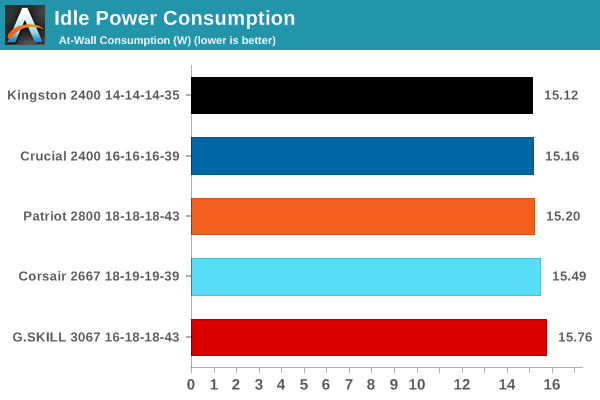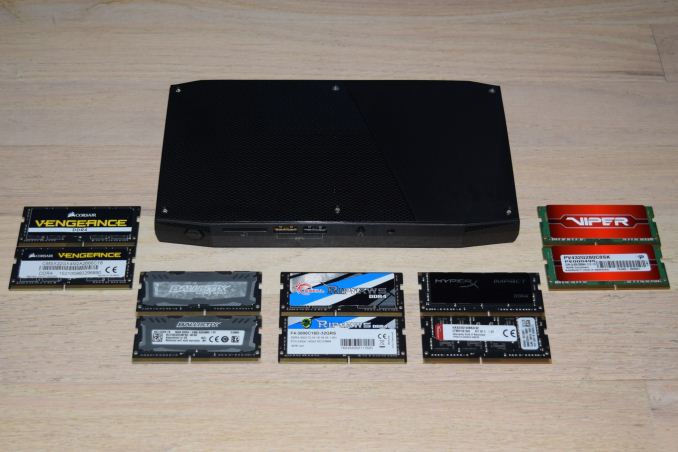Memory Frequency Scaling on Intel's Skull Canyon NUC - An Investigation
by Ganesh T S on August 29, 2016 8:00 AM ESTMiscellaneous Aspects and Concluding Remarks
Improved memory bandwidth and reduced latency constitute the performance benefits of using high frequency SODIMM kits in the NUC6i7KYK. Another aspect is the difference in power consumption between the various modules. Intel's Skylake-H datasheet mentions that increasing the DDR4 rate from 1866 MHz to 2133 MHz may lead to a TDP power penalty of up to 400mW. This is only on the processor side, and doesn't consider the memory kit at all. To get a full view of the impact of different memory kits, we monitored the power consumed at the wall by the Skull Canyon NUC with an idle desktop and averaged it over a duration of 1 hour.

As expected, higher frequency kits do consume more power, but, again, the differences are minimal and may even vary from one idle time interval to another.
We looked up the pricing for the various 32GB kits prior to posting, and found that the street price varied from $140 to $190. Thanks to its stellar specifications, the G.Skill Ripjaws F4-3000C16D-32GRS is able to command the highest street price. The Crucial kit is the most economical of the lot.
| Premium DRAM Options for the Skull Canyon NUC (NUC6i7KYK) | |||
| Memory Kit | Tested Frequency (MHz) |
Tested Timing (tCL-tRCD-tRP-tRAS-tRFC) |
Price (USD) |
| Corsair Vengeance CMSX32GX4M2A2666C18 |
2667 | 18-19-19-39-467 | $160 |
| Crucial Ballistix Sport LT BLS2K16G4S240FSD |
2400 | 16-16-16-39-421 | $140 |
| G.Skill Ripjaws F4-3000C16D-32GRS |
3067 | 16-18-18-43-421 | $190 |
| Kingston HyperX Impact HX424S14IBK2/32 |
2400 | 14-14-14-35-421 | $158 |
| Patriot Viper Series PV432G280C8SK |
2800 | 18-18-18-43-491 | $180 |
Wrapping things up, we have put various 32GB DDR4 SODIMM kits through different benchmarks in the NUC6i7KYK, and what we have found is that they all largely perform the same when it comes to real-world workloads. Strict speaking, faster kits do improve average performance, but the ever so slight performance increase isn't enough to matter. With that said, there are a few workloads that can definitely benefit from the faster memory kits, but they tend to be professional use-cases rather than the kinds of consumer workloads Skull Canyon was meant for, such as entry level gaming.
I suspect that the processor configuration (128MB eDRAM) is playing a major role in ensuring that the experience with normal real-world workloads remains the same irrespective of whether it is running a 2400 MHz C16 kit or a 3000 MHz C16 one. The eDRAM keeps the obvious memory bottleneck - the iGPU - from being bandwidth starved, and it can also better feed desktop applications in some situations as well. However if that's the case, then desktop and notebook system users with a different non-eDRAM processor might observe different results. Ultimately if price is not a major concern, going with the G.Skill Ripjaws 3000 MHz kit is good for any system that supports DDR4 SODIMMs operating at that frequency. Otherwise, we recommend that consumers go for the kit that offers the best value for money at the time of purchase.











31 Comments
View All Comments
jjj - Monday, August 29, 2016 - link
The second graph on page 3 should be flipped upside down as lower latency is better and right now it is misleading if you aren't paying attention.snowmyr - Monday, August 29, 2016 - link
http://imgur.com/a/GxZWhYou're Welcome
kebo - Tuesday, August 30, 2016 - link
+1 internetsGigaplex - Monday, August 29, 2016 - link
"Upon booting into the BIOS after installation, I found that the memory was only configured to run at 2667 MHz. Altering the 'Automatic' DRAM timings to 'Manual' and 'user-defining' the various timing parameters as printed on the SODIMM label (16-18-18-43) enabled higher frequency operation."I'm not surprised. My G.Skill RAM (DDR3) also didn't perform as advertised in a plug and play fashion, and when I emailed to complain, they acted as if it was normal for manual entry to be required. So much for XMP compliance.
Ian Cutress - Monday, August 29, 2016 - link
The system BIOS automatically loads the SPD profile of the memory kit unless the XMP option is enabled. In most systems, XMP is disabled as the default option because kits without XMP (most of the base ones) don't exist. Also, the SPD profile is typically left as the base JEDEC settings to ensure full compatibility.If you want true plug and play of high speed memory kits, one of two things need to happen:
1) XMP is enabled by default (but not all memory will work)
2) Base SPD profiles on the memory should be the high-speed option (means the memory won't work in systems not geared for high performance)
There are a number of Kingston modules, typically DDR4-2400/2666, that will use option number (2). Some high-end motherboards have an onboard switch for (1). For everything else, it requires manually adjusting a setting in the BIOS.
The problem, as always, is maintaining wide compatibility. Just in case someone buys a high-end memory kit but wants to run it at base JEDEC specifications, because the hardware they are moving the kit into doesn't support the high frequency.
TheinsanegamerN - Monday, August 29, 2016 - link
dissapointing to see nearly no improvement in gaming benchmarks. You'd figure that a big iGPU would need more bandwidth with newer games.Perhaps current iGPUs just are not powerful enough. Maybe AMD will fix that with zen APUs next year.
Ian Cutress - Monday, August 29, 2016 - link
It's a function of the embedded DRAM. You would expect DRAM speed to affect the iGPU less when eDRAM is present because it provides a large 50GB/s bidirectional DRAM buffer. Without eDRAM, I would expect the differences in gaming results to be more. Will have to do testing to find out - this piece was focusing primarily on the Skull Canyon environment which lists high speed memory support as a benefit.Samus - Monday, August 29, 2016 - link
I haven't seen a memory frequency roundup like this since Sandy Bridge, which did show a slight benefit (more than Skylake for sure) moving from DDR3 1066 through 1333, 1600 and so on. Haswell I'm sure is a similar story. I had noticeable performance improvements on AM3+ platforms going from 1600 to 2400 especially in regard to the embedded GPU.With sky lake it seems you are just wasting your money to run potentially less reliable, more expensive memory out of specification. But I wonder if CPUs without the eDRAM have the same flat scale?
Ian Cutress - Monday, August 29, 2016 - link
Ivy Bridge: http://www.anandtech.com/show/6372/memory-performa...Haswell: http://www.anandtech.com/show/7364/memory-scaling-...
Samus - Monday, August 29, 2016 - link
Oh cool, thanks Ian! Should have figured you guys keep up with it.